What a Leader Must Focus On -
VerifiedAdded on 2022/08/24
|15
|4018
|24
AI Summary
Contribute Materials
Your contribution can guide someone’s learning journey. Share your
documents today.

Secure Best Marks with AI Grader
Need help grading? Try our AI Grader for instant feedback on your assignments.
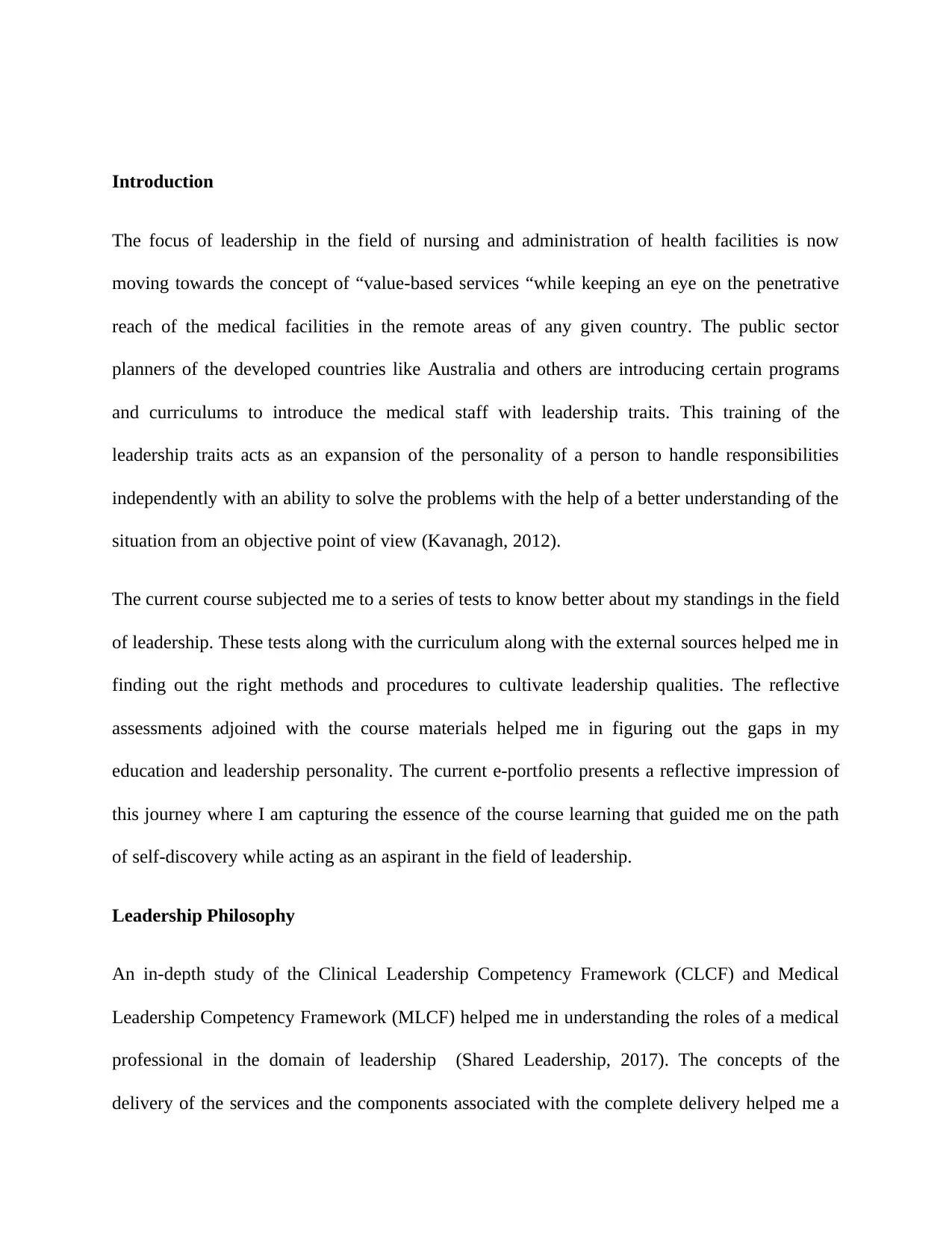
Introduction
The focus of leadership in the field of nursing and administration of health facilities is now
moving towards the concept of “value-based services “while keeping an eye on the penetrative
reach of the medical facilities in the remote areas of any given country. The public sector
planners of the developed countries like Australia and others are introducing certain programs
and curriculums to introduce the medical staff with leadership traits. This training of the
leadership traits acts as an expansion of the personality of a person to handle responsibilities
independently with an ability to solve the problems with the help of a better understanding of the
situation from an objective point of view (Kavanagh, 2012).
The current course subjected me to a series of tests to know better about my standings in the field
of leadership. These tests along with the curriculum along with the external sources helped me in
finding out the right methods and procedures to cultivate leadership qualities. The reflective
assessments adjoined with the course materials helped me in figuring out the gaps in my
education and leadership personality. The current e-portfolio presents a reflective impression of
this journey where I am capturing the essence of the course learning that guided me on the path
of self-discovery while acting as an aspirant in the field of leadership.
Leadership Philosophy
An in-depth study of the Clinical Leadership Competency Framework (CLCF) and Medical
Leadership Competency Framework (MLCF) helped me in understanding the roles of a medical
professional in the domain of leadership (Shared Leadership, 2017). The concepts of the
delivery of the services and the components associated with the complete delivery helped me a
The focus of leadership in the field of nursing and administration of health facilities is now
moving towards the concept of “value-based services “while keeping an eye on the penetrative
reach of the medical facilities in the remote areas of any given country. The public sector
planners of the developed countries like Australia and others are introducing certain programs
and curriculums to introduce the medical staff with leadership traits. This training of the
leadership traits acts as an expansion of the personality of a person to handle responsibilities
independently with an ability to solve the problems with the help of a better understanding of the
situation from an objective point of view (Kavanagh, 2012).
The current course subjected me to a series of tests to know better about my standings in the field
of leadership. These tests along with the curriculum along with the external sources helped me in
finding out the right methods and procedures to cultivate leadership qualities. The reflective
assessments adjoined with the course materials helped me in figuring out the gaps in my
education and leadership personality. The current e-portfolio presents a reflective impression of
this journey where I am capturing the essence of the course learning that guided me on the path
of self-discovery while acting as an aspirant in the field of leadership.
Leadership Philosophy
An in-depth study of the Clinical Leadership Competency Framework (CLCF) and Medical
Leadership Competency Framework (MLCF) helped me in understanding the roles of a medical
professional in the domain of leadership (Shared Leadership, 2017). The concepts of the
delivery of the services and the components associated with the complete delivery helped me a
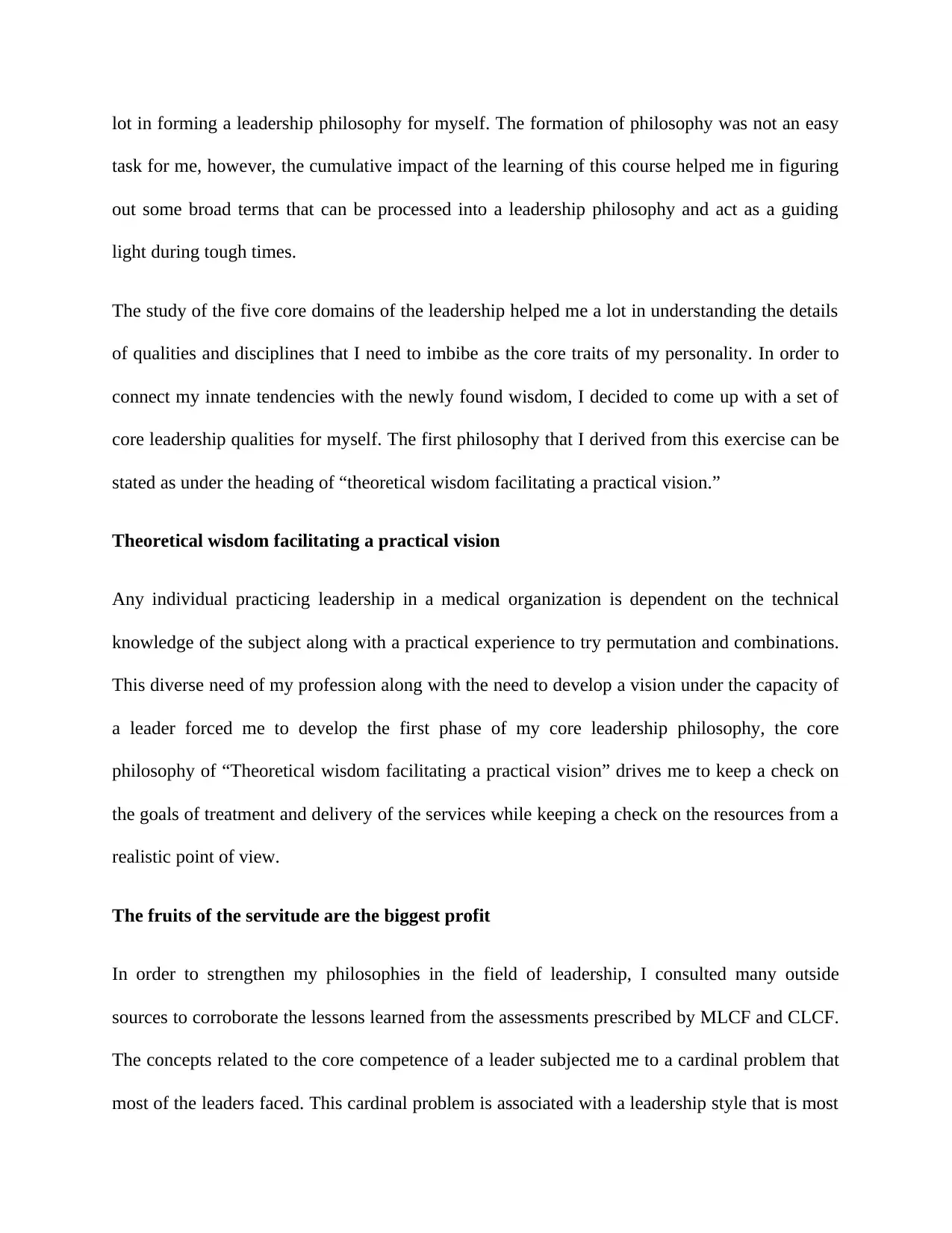
lot in forming a leadership philosophy for myself. The formation of philosophy was not an easy
task for me, however, the cumulative impact of the learning of this course helped me in figuring
out some broad terms that can be processed into a leadership philosophy and act as a guiding
light during tough times.
The study of the five core domains of the leadership helped me a lot in understanding the details
of qualities and disciplines that I need to imbibe as the core traits of my personality. In order to
connect my innate tendencies with the newly found wisdom, I decided to come up with a set of
core leadership qualities for myself. The first philosophy that I derived from this exercise can be
stated as under the heading of “theoretical wisdom facilitating a practical vision.”
Theoretical wisdom facilitating a practical vision
Any individual practicing leadership in a medical organization is dependent on the technical
knowledge of the subject along with a practical experience to try permutation and combinations.
This diverse need of my profession along with the need to develop a vision under the capacity of
a leader forced me to develop the first phase of my core leadership philosophy, the core
philosophy of “Theoretical wisdom facilitating a practical vision” drives me to keep a check on
the goals of treatment and delivery of the services while keeping a check on the resources from a
realistic point of view.
The fruits of the servitude are the biggest profit
In order to strengthen my philosophies in the field of leadership, I consulted many outside
sources to corroborate the lessons learned from the assessments prescribed by MLCF and CLCF.
The concepts related to the core competence of a leader subjected me to a cardinal problem that
most of the leaders faced. This cardinal problem is associated with a leadership style that is most
task for me, however, the cumulative impact of the learning of this course helped me in figuring
out some broad terms that can be processed into a leadership philosophy and act as a guiding
light during tough times.
The study of the five core domains of the leadership helped me a lot in understanding the details
of qualities and disciplines that I need to imbibe as the core traits of my personality. In order to
connect my innate tendencies with the newly found wisdom, I decided to come up with a set of
core leadership qualities for myself. The first philosophy that I derived from this exercise can be
stated as under the heading of “theoretical wisdom facilitating a practical vision.”
Theoretical wisdom facilitating a practical vision
Any individual practicing leadership in a medical organization is dependent on the technical
knowledge of the subject along with a practical experience to try permutation and combinations.
This diverse need of my profession along with the need to develop a vision under the capacity of
a leader forced me to develop the first phase of my core leadership philosophy, the core
philosophy of “Theoretical wisdom facilitating a practical vision” drives me to keep a check on
the goals of treatment and delivery of the services while keeping a check on the resources from a
realistic point of view.
The fruits of the servitude are the biggest profit
In order to strengthen my philosophies in the field of leadership, I consulted many outside
sources to corroborate the lessons learned from the assessments prescribed by MLCF and CLCF.
The concepts related to the core competence of a leader subjected me to a cardinal problem that
most of the leaders faced. This cardinal problem is associated with a leadership style that is most
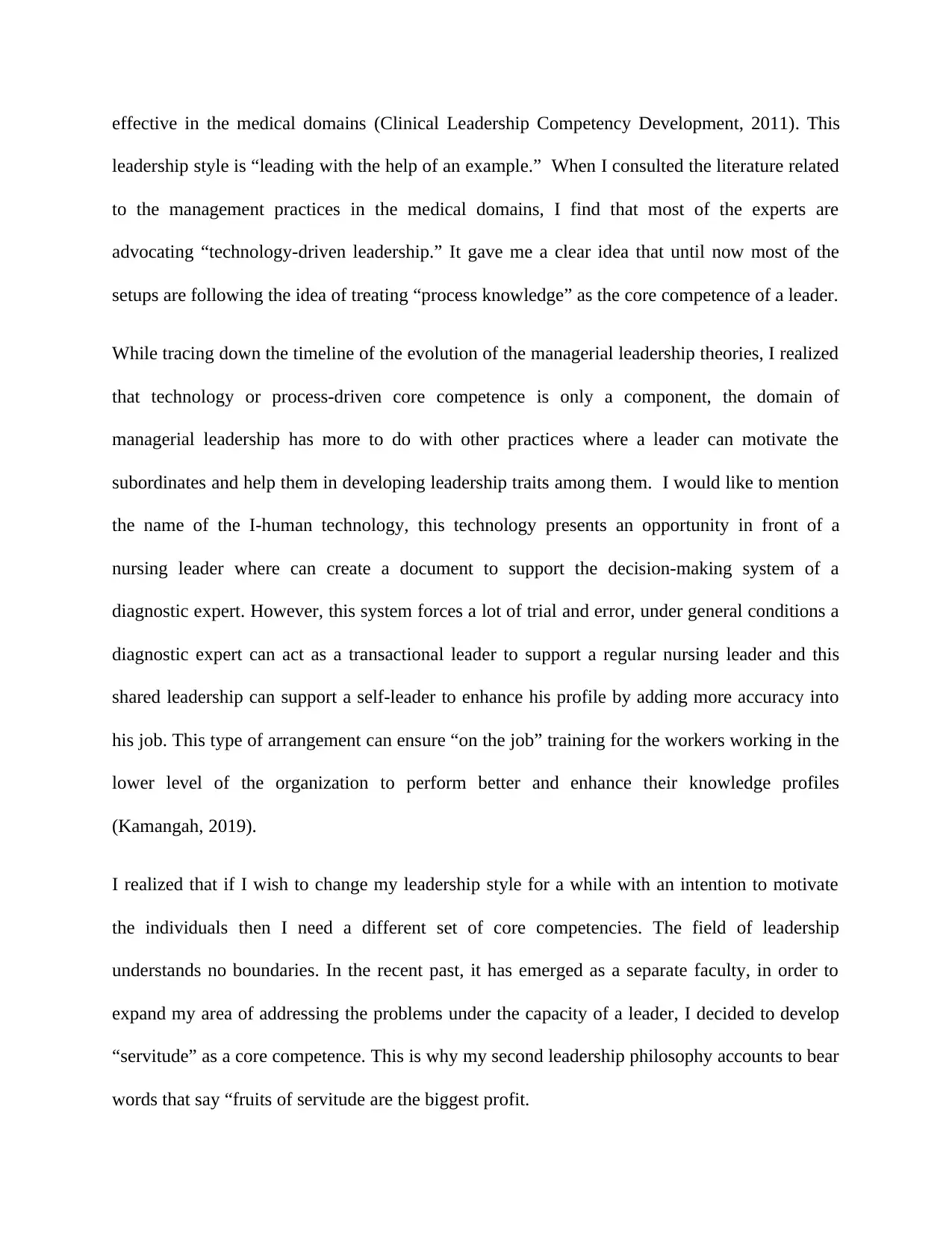
effective in the medical domains (Clinical Leadership Competency Development, 2011). This
leadership style is “leading with the help of an example.” When I consulted the literature related
to the management practices in the medical domains, I find that most of the experts are
advocating “technology-driven leadership.” It gave me a clear idea that until now most of the
setups are following the idea of treating “process knowledge” as the core competence of a leader.
While tracing down the timeline of the evolution of the managerial leadership theories, I realized
that technology or process-driven core competence is only a component, the domain of
managerial leadership has more to do with other practices where a leader can motivate the
subordinates and help them in developing leadership traits among them. I would like to mention
the name of the I-human technology, this technology presents an opportunity in front of a
nursing leader where can create a document to support the decision-making system of a
diagnostic expert. However, this system forces a lot of trial and error, under general conditions a
diagnostic expert can act as a transactional leader to support a regular nursing leader and this
shared leadership can support a self-leader to enhance his profile by adding more accuracy into
his job. This type of arrangement can ensure “on the job” training for the workers working in the
lower level of the organization to perform better and enhance their knowledge profiles
(Kamangah, 2019).
I realized that if I wish to change my leadership style for a while with an intention to motivate
the individuals then I need a different set of core competencies. The field of leadership
understands no boundaries. In the recent past, it has emerged as a separate faculty, in order to
expand my area of addressing the problems under the capacity of a leader, I decided to develop
“servitude” as a core competence. This is why my second leadership philosophy accounts to bear
words that say “fruits of servitude are the biggest profit.
leadership style is “leading with the help of an example.” When I consulted the literature related
to the management practices in the medical domains, I find that most of the experts are
advocating “technology-driven leadership.” It gave me a clear idea that until now most of the
setups are following the idea of treating “process knowledge” as the core competence of a leader.
While tracing down the timeline of the evolution of the managerial leadership theories, I realized
that technology or process-driven core competence is only a component, the domain of
managerial leadership has more to do with other practices where a leader can motivate the
subordinates and help them in developing leadership traits among them. I would like to mention
the name of the I-human technology, this technology presents an opportunity in front of a
nursing leader where can create a document to support the decision-making system of a
diagnostic expert. However, this system forces a lot of trial and error, under general conditions a
diagnostic expert can act as a transactional leader to support a regular nursing leader and this
shared leadership can support a self-leader to enhance his profile by adding more accuracy into
his job. This type of arrangement can ensure “on the job” training for the workers working in the
lower level of the organization to perform better and enhance their knowledge profiles
(Kamangah, 2019).
I realized that if I wish to change my leadership style for a while with an intention to motivate
the individuals then I need a different set of core competencies. The field of leadership
understands no boundaries. In the recent past, it has emerged as a separate faculty, in order to
expand my area of addressing the problems under the capacity of a leader, I decided to develop
“servitude” as a core competence. This is why my second leadership philosophy accounts to bear
words that say “fruits of servitude are the biggest profit.
Secure Best Marks with AI Grader
Need help grading? Try our AI Grader for instant feedback on your assignments.
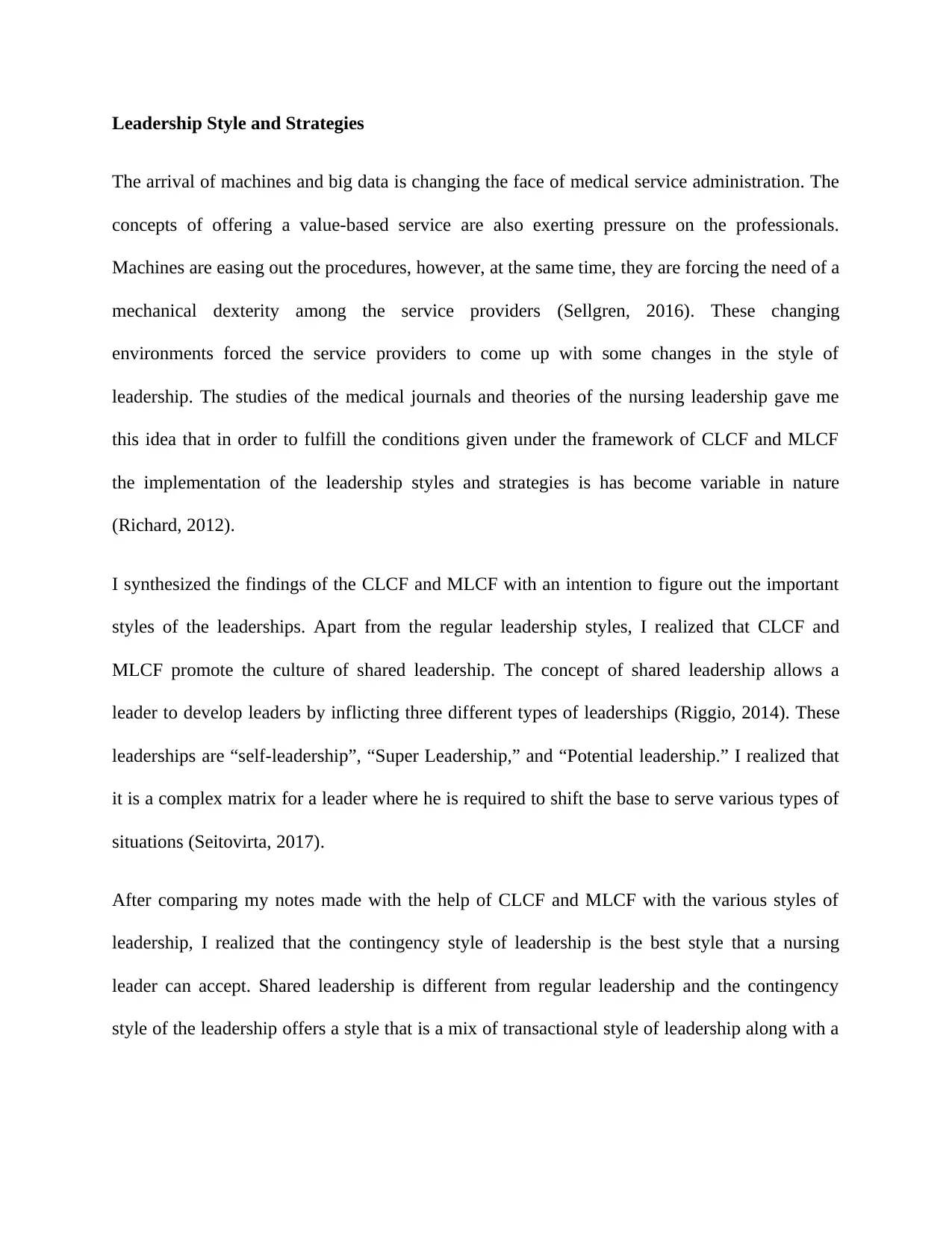
Leadership Style and Strategies
The arrival of machines and big data is changing the face of medical service administration. The
concepts of offering a value-based service are also exerting pressure on the professionals.
Machines are easing out the procedures, however, at the same time, they are forcing the need of a
mechanical dexterity among the service providers (Sellgren, 2016). These changing
environments forced the service providers to come up with some changes in the style of
leadership. The studies of the medical journals and theories of the nursing leadership gave me
this idea that in order to fulfill the conditions given under the framework of CLCF and MLCF
the implementation of the leadership styles and strategies is has become variable in nature
(Richard, 2012).
I synthesized the findings of the CLCF and MLCF with an intention to figure out the important
styles of the leaderships. Apart from the regular leadership styles, I realized that CLCF and
MLCF promote the culture of shared leadership. The concept of shared leadership allows a
leader to develop leaders by inflicting three different types of leaderships (Riggio, 2014). These
leaderships are “self-leadership”, “Super Leadership,” and “Potential leadership.” I realized that
it is a complex matrix for a leader where he is required to shift the base to serve various types of
situations (Seitovirta, 2017).
After comparing my notes made with the help of CLCF and MLCF with the various styles of
leadership, I realized that the contingency style of leadership is the best style that a nursing
leader can accept. Shared leadership is different from regular leadership and the contingency
style of the leadership offers a style that is a mix of transactional style of leadership along with a
The arrival of machines and big data is changing the face of medical service administration. The
concepts of offering a value-based service are also exerting pressure on the professionals.
Machines are easing out the procedures, however, at the same time, they are forcing the need of a
mechanical dexterity among the service providers (Sellgren, 2016). These changing
environments forced the service providers to come up with some changes in the style of
leadership. The studies of the medical journals and theories of the nursing leadership gave me
this idea that in order to fulfill the conditions given under the framework of CLCF and MLCF
the implementation of the leadership styles and strategies is has become variable in nature
(Richard, 2012).
I synthesized the findings of the CLCF and MLCF with an intention to figure out the important
styles of the leaderships. Apart from the regular leadership styles, I realized that CLCF and
MLCF promote the culture of shared leadership. The concept of shared leadership allows a
leader to develop leaders by inflicting three different types of leaderships (Riggio, 2014). These
leaderships are “self-leadership”, “Super Leadership,” and “Potential leadership.” I realized that
it is a complex matrix for a leader where he is required to shift the base to serve various types of
situations (Seitovirta, 2017).
After comparing my notes made with the help of CLCF and MLCF with the various styles of
leadership, I realized that the contingency style of leadership is the best style that a nursing
leader can accept. Shared leadership is different from regular leadership and the contingency
style of the leadership offers a style that is a mix of transactional style of leadership along with a
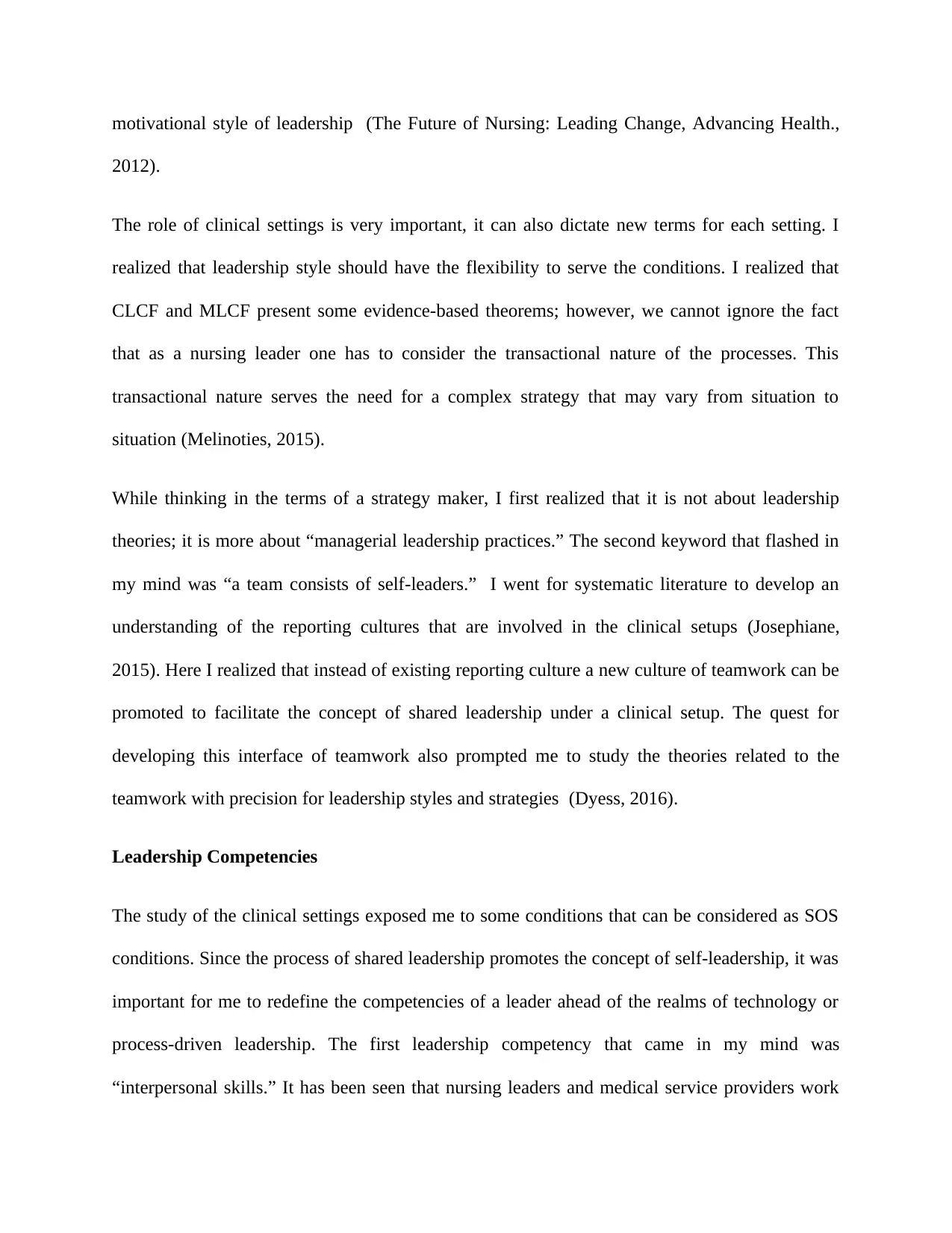
motivational style of leadership (The Future of Nursing: Leading Change, Advancing Health.,
2012).
The role of clinical settings is very important, it can also dictate new terms for each setting. I
realized that leadership style should have the flexibility to serve the conditions. I realized that
CLCF and MLCF present some evidence-based theorems; however, we cannot ignore the fact
that as a nursing leader one has to consider the transactional nature of the processes. This
transactional nature serves the need for a complex strategy that may vary from situation to
situation (Melinoties, 2015).
While thinking in the terms of a strategy maker, I first realized that it is not about leadership
theories; it is more about “managerial leadership practices.” The second keyword that flashed in
my mind was “a team consists of self-leaders.” I went for systematic literature to develop an
understanding of the reporting cultures that are involved in the clinical setups (Josephiane,
2015). Here I realized that instead of existing reporting culture a new culture of teamwork can be
promoted to facilitate the concept of shared leadership under a clinical setup. The quest for
developing this interface of teamwork also prompted me to study the theories related to the
teamwork with precision for leadership styles and strategies (Dyess, 2016).
Leadership Competencies
The study of the clinical settings exposed me to some conditions that can be considered as SOS
conditions. Since the process of shared leadership promotes the concept of self-leadership, it was
important for me to redefine the competencies of a leader ahead of the realms of technology or
process-driven leadership. The first leadership competency that came in my mind was
“interpersonal skills.” It has been seen that nursing leaders and medical service providers work
2012).
The role of clinical settings is very important, it can also dictate new terms for each setting. I
realized that leadership style should have the flexibility to serve the conditions. I realized that
CLCF and MLCF present some evidence-based theorems; however, we cannot ignore the fact
that as a nursing leader one has to consider the transactional nature of the processes. This
transactional nature serves the need for a complex strategy that may vary from situation to
situation (Melinoties, 2015).
While thinking in the terms of a strategy maker, I first realized that it is not about leadership
theories; it is more about “managerial leadership practices.” The second keyword that flashed in
my mind was “a team consists of self-leaders.” I went for systematic literature to develop an
understanding of the reporting cultures that are involved in the clinical setups (Josephiane,
2015). Here I realized that instead of existing reporting culture a new culture of teamwork can be
promoted to facilitate the concept of shared leadership under a clinical setup. The quest for
developing this interface of teamwork also prompted me to study the theories related to the
teamwork with precision for leadership styles and strategies (Dyess, 2016).
Leadership Competencies
The study of the clinical settings exposed me to some conditions that can be considered as SOS
conditions. Since the process of shared leadership promotes the concept of self-leadership, it was
important for me to redefine the competencies of a leader ahead of the realms of technology or
process-driven leadership. The first leadership competency that came in my mind was
“interpersonal skills.” It has been seen that nursing leaders and medical service providers work
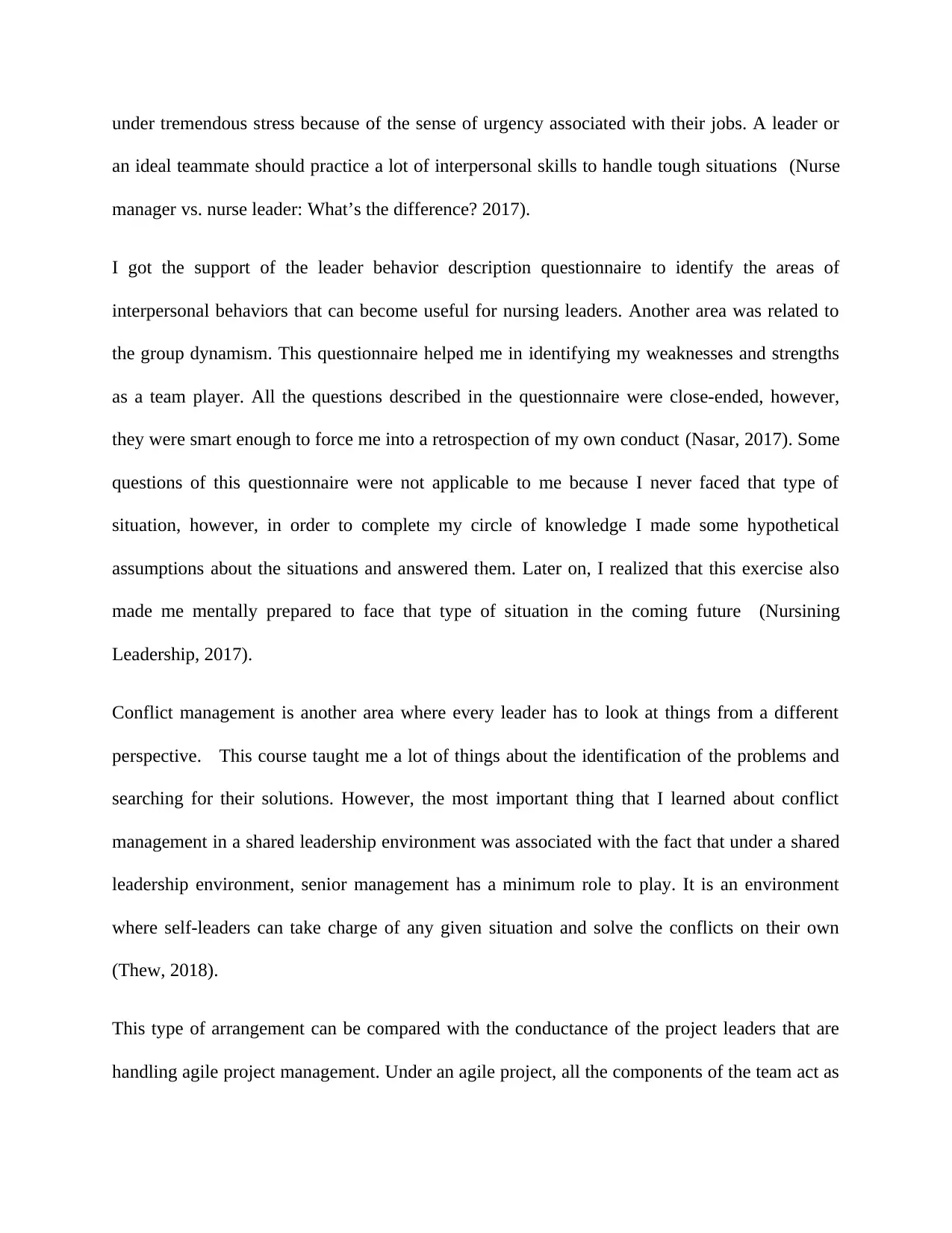
under tremendous stress because of the sense of urgency associated with their jobs. A leader or
an ideal teammate should practice a lot of interpersonal skills to handle tough situations (Nurse
manager vs. nurse leader: What’s the difference? 2017).
I got the support of the leader behavior description questionnaire to identify the areas of
interpersonal behaviors that can become useful for nursing leaders. Another area was related to
the group dynamism. This questionnaire helped me in identifying my weaknesses and strengths
as a team player. All the questions described in the questionnaire were close-ended, however,
they were smart enough to force me into a retrospection of my own conduct (Nasar, 2017). Some
questions of this questionnaire were not applicable to me because I never faced that type of
situation, however, in order to complete my circle of knowledge I made some hypothetical
assumptions about the situations and answered them. Later on, I realized that this exercise also
made me mentally prepared to face that type of situation in the coming future (Nursining
Leadership, 2017).
Conflict management is another area where every leader has to look at things from a different
perspective. This course taught me a lot of things about the identification of the problems and
searching for their solutions. However, the most important thing that I learned about conflict
management in a shared leadership environment was associated with the fact that under a shared
leadership environment, senior management has a minimum role to play. It is an environment
where self-leaders can take charge of any given situation and solve the conflicts on their own
(Thew, 2018).
This type of arrangement can be compared with the conductance of the project leaders that are
handling agile project management. Under an agile project, all the components of the team act as
an ideal teammate should practice a lot of interpersonal skills to handle tough situations (Nurse
manager vs. nurse leader: What’s the difference? 2017).
I got the support of the leader behavior description questionnaire to identify the areas of
interpersonal behaviors that can become useful for nursing leaders. Another area was related to
the group dynamism. This questionnaire helped me in identifying my weaknesses and strengths
as a team player. All the questions described in the questionnaire were close-ended, however,
they were smart enough to force me into a retrospection of my own conduct (Nasar, 2017). Some
questions of this questionnaire were not applicable to me because I never faced that type of
situation, however, in order to complete my circle of knowledge I made some hypothetical
assumptions about the situations and answered them. Later on, I realized that this exercise also
made me mentally prepared to face that type of situation in the coming future (Nursining
Leadership, 2017).
Conflict management is another area where every leader has to look at things from a different
perspective. This course taught me a lot of things about the identification of the problems and
searching for their solutions. However, the most important thing that I learned about conflict
management in a shared leadership environment was associated with the fact that under a shared
leadership environment, senior management has a minimum role to play. It is an environment
where self-leaders can take charge of any given situation and solve the conflicts on their own
(Thew, 2018).
This type of arrangement can be compared with the conductance of the project leaders that are
handling agile project management. Under an agile project, all the components of the team act as
Paraphrase This Document
Need a fresh take? Get an instant paraphrase of this document with our AI Paraphraser
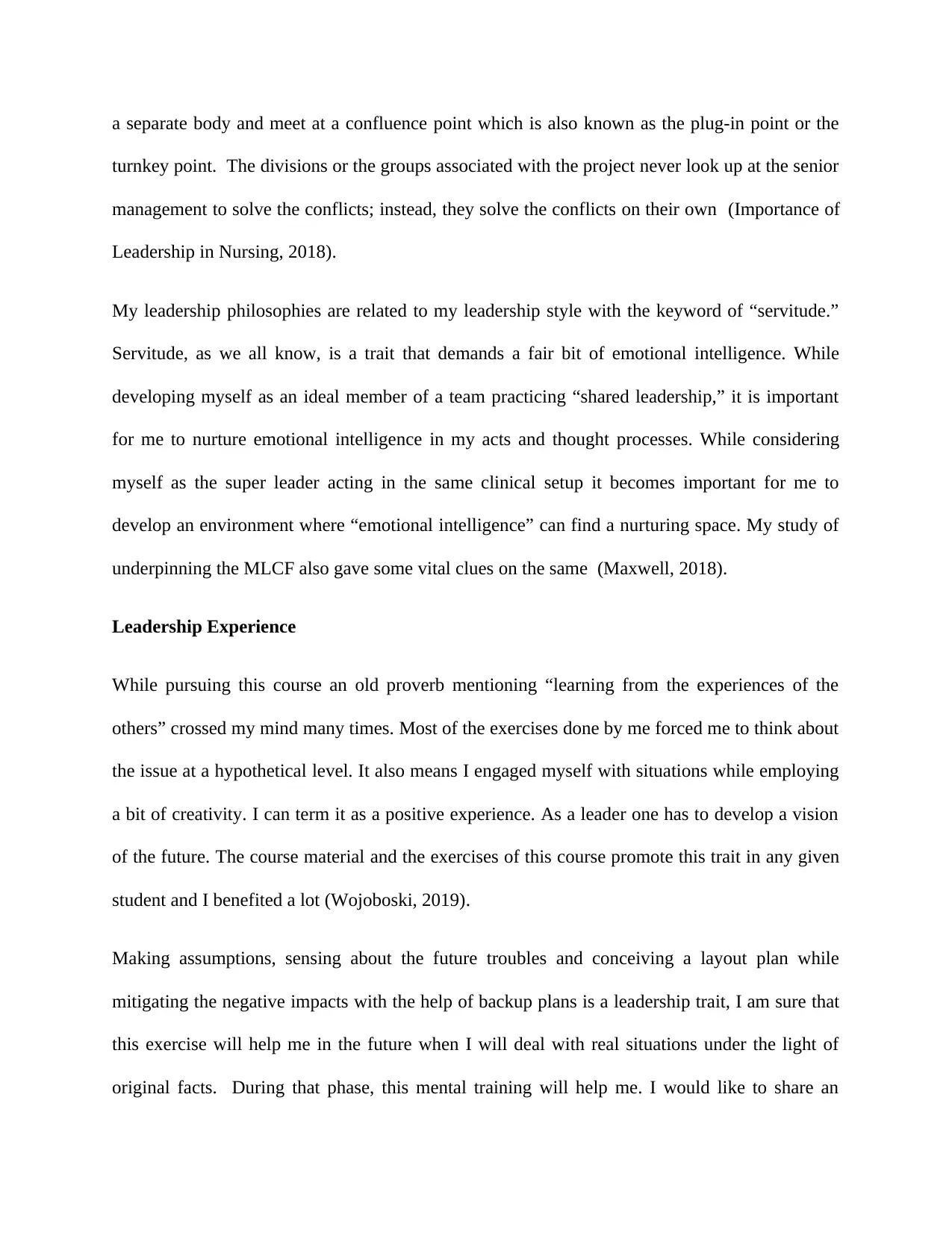
a separate body and meet at a confluence point which is also known as the plug-in point or the
turnkey point. The divisions or the groups associated with the project never look up at the senior
management to solve the conflicts; instead, they solve the conflicts on their own (Importance of
Leadership in Nursing, 2018).
My leadership philosophies are related to my leadership style with the keyword of “servitude.”
Servitude, as we all know, is a trait that demands a fair bit of emotional intelligence. While
developing myself as an ideal member of a team practicing “shared leadership,” it is important
for me to nurture emotional intelligence in my acts and thought processes. While considering
myself as the super leader acting in the same clinical setup it becomes important for me to
develop an environment where “emotional intelligence” can find a nurturing space. My study of
underpinning the MLCF also gave some vital clues on the same (Maxwell, 2018).
Leadership Experience
While pursuing this course an old proverb mentioning “learning from the experiences of the
others” crossed my mind many times. Most of the exercises done by me forced me to think about
the issue at a hypothetical level. It also means I engaged myself with situations while employing
a bit of creativity. I can term it as a positive experience. As a leader one has to develop a vision
of the future. The course material and the exercises of this course promote this trait in any given
student and I benefited a lot (Wojoboski, 2019).
Making assumptions, sensing about the future troubles and conceiving a layout plan while
mitigating the negative impacts with the help of backup plans is a leadership trait, I am sure that
this exercise will help me in the future when I will deal with real situations under the light of
original facts. During that phase, this mental training will help me. I would like to share an
turnkey point. The divisions or the groups associated with the project never look up at the senior
management to solve the conflicts; instead, they solve the conflicts on their own (Importance of
Leadership in Nursing, 2018).
My leadership philosophies are related to my leadership style with the keyword of “servitude.”
Servitude, as we all know, is a trait that demands a fair bit of emotional intelligence. While
developing myself as an ideal member of a team practicing “shared leadership,” it is important
for me to nurture emotional intelligence in my acts and thought processes. While considering
myself as the super leader acting in the same clinical setup it becomes important for me to
develop an environment where “emotional intelligence” can find a nurturing space. My study of
underpinning the MLCF also gave some vital clues on the same (Maxwell, 2018).
Leadership Experience
While pursuing this course an old proverb mentioning “learning from the experiences of the
others” crossed my mind many times. Most of the exercises done by me forced me to think about
the issue at a hypothetical level. It also means I engaged myself with situations while employing
a bit of creativity. I can term it as a positive experience. As a leader one has to develop a vision
of the future. The course material and the exercises of this course promote this trait in any given
student and I benefited a lot (Wojoboski, 2019).
Making assumptions, sensing about the future troubles and conceiving a layout plan while
mitigating the negative impacts with the help of backup plans is a leadership trait, I am sure that
this exercise will help me in the future when I will deal with real situations under the light of
original facts. During that phase, this mental training will help me. I would like to share an
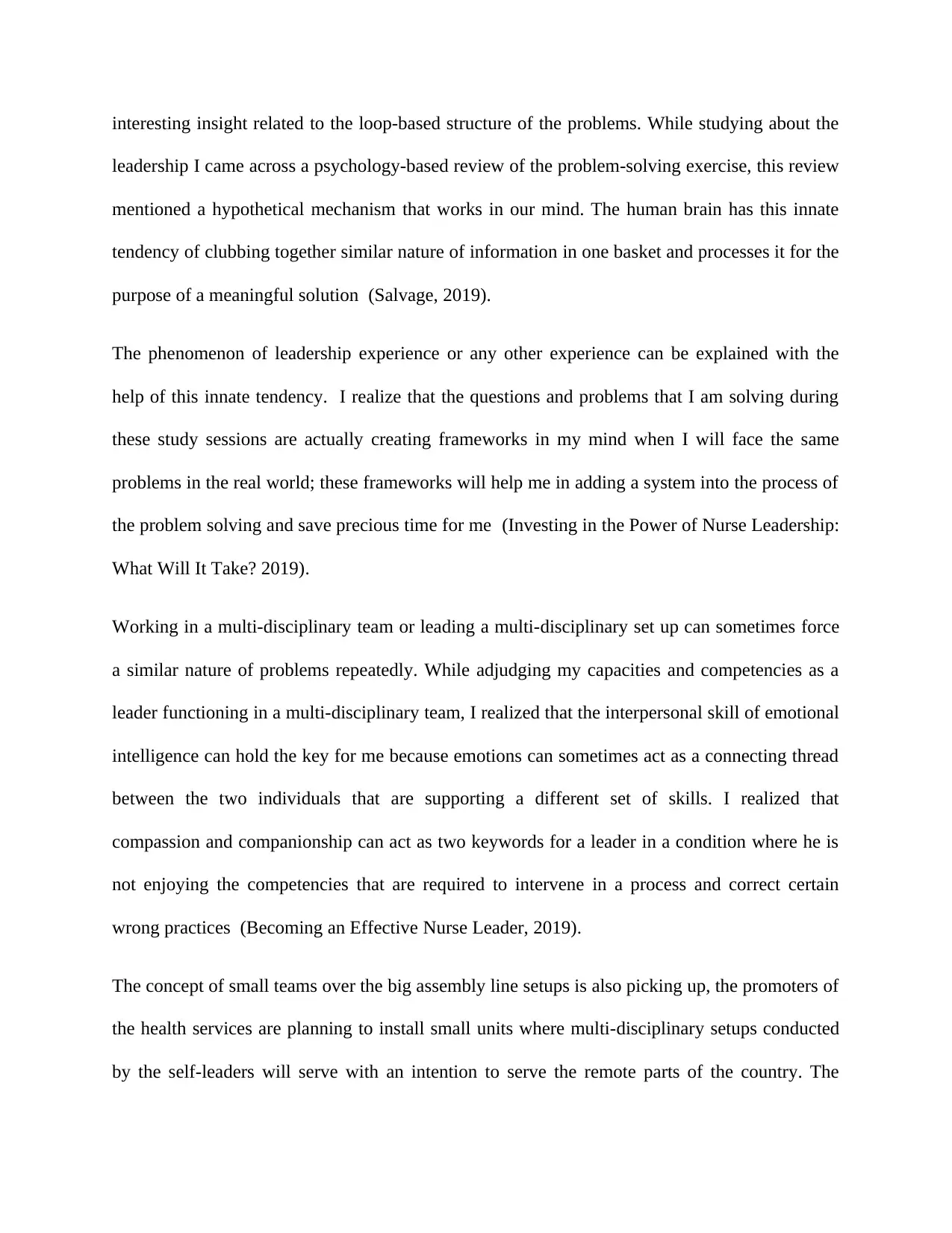
interesting insight related to the loop-based structure of the problems. While studying about the
leadership I came across a psychology-based review of the problem-solving exercise, this review
mentioned a hypothetical mechanism that works in our mind. The human brain has this innate
tendency of clubbing together similar nature of information in one basket and processes it for the
purpose of a meaningful solution (Salvage, 2019).
The phenomenon of leadership experience or any other experience can be explained with the
help of this innate tendency. I realize that the questions and problems that I am solving during
these study sessions are actually creating frameworks in my mind when I will face the same
problems in the real world; these frameworks will help me in adding a system into the process of
the problem solving and save precious time for me (Investing in the Power of Nurse Leadership:
What Will It Take? 2019).
Working in a multi-disciplinary team or leading a multi-disciplinary set up can sometimes force
a similar nature of problems repeatedly. While adjudging my capacities and competencies as a
leader functioning in a multi-disciplinary team, I realized that the interpersonal skill of emotional
intelligence can hold the key for me because emotions can sometimes act as a connecting thread
between the two individuals that are supporting a different set of skills. I realized that
compassion and companionship can act as two keywords for a leader in a condition where he is
not enjoying the competencies that are required to intervene in a process and correct certain
wrong practices (Becoming an Effective Nurse Leader, 2019).
The concept of small teams over the big assembly line setups is also picking up, the promoters of
the health services are planning to install small units where multi-disciplinary setups conducted
by the self-leaders will serve with an intention to serve the remote parts of the country. The
leadership I came across a psychology-based review of the problem-solving exercise, this review
mentioned a hypothetical mechanism that works in our mind. The human brain has this innate
tendency of clubbing together similar nature of information in one basket and processes it for the
purpose of a meaningful solution (Salvage, 2019).
The phenomenon of leadership experience or any other experience can be explained with the
help of this innate tendency. I realize that the questions and problems that I am solving during
these study sessions are actually creating frameworks in my mind when I will face the same
problems in the real world; these frameworks will help me in adding a system into the process of
the problem solving and save precious time for me (Investing in the Power of Nurse Leadership:
What Will It Take? 2019).
Working in a multi-disciplinary team or leading a multi-disciplinary set up can sometimes force
a similar nature of problems repeatedly. While adjudging my capacities and competencies as a
leader functioning in a multi-disciplinary team, I realized that the interpersonal skill of emotional
intelligence can hold the key for me because emotions can sometimes act as a connecting thread
between the two individuals that are supporting a different set of skills. I realized that
compassion and companionship can act as two keywords for a leader in a condition where he is
not enjoying the competencies that are required to intervene in a process and correct certain
wrong practices (Becoming an Effective Nurse Leader, 2019).
The concept of small teams over the big assembly line setups is also picking up, the promoters of
the health services are planning to install small units where multi-disciplinary setups conducted
by the self-leaders will serve with an intention to serve the remote parts of the country. The
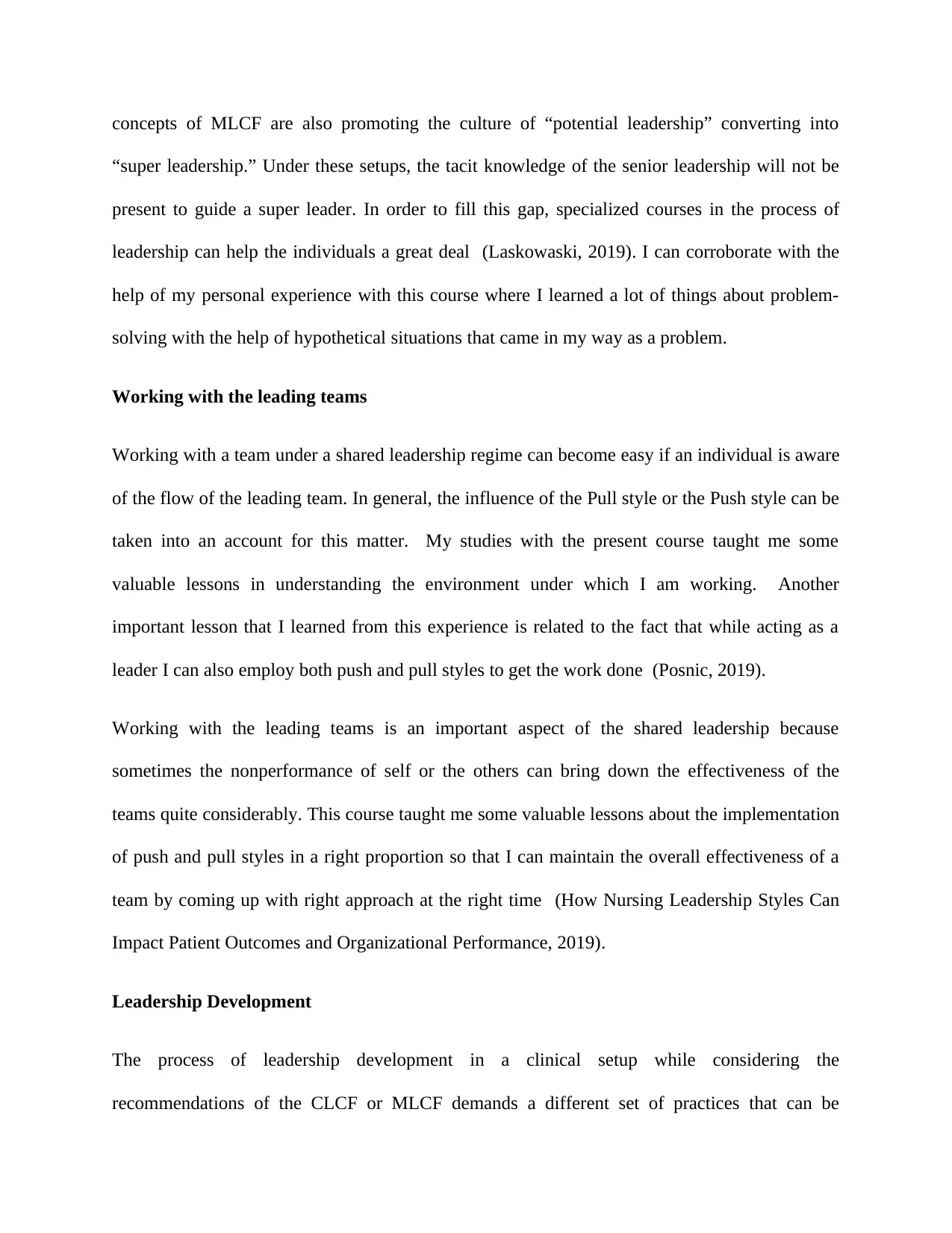
concepts of MLCF are also promoting the culture of “potential leadership” converting into
“super leadership.” Under these setups, the tacit knowledge of the senior leadership will not be
present to guide a super leader. In order to fill this gap, specialized courses in the process of
leadership can help the individuals a great deal (Laskowaski, 2019). I can corroborate with the
help of my personal experience with this course where I learned a lot of things about problem-
solving with the help of hypothetical situations that came in my way as a problem.
Working with the leading teams
Working with a team under a shared leadership regime can become easy if an individual is aware
of the flow of the leading team. In general, the influence of the Pull style or the Push style can be
taken into an account for this matter. My studies with the present course taught me some
valuable lessons in understanding the environment under which I am working. Another
important lesson that I learned from this experience is related to the fact that while acting as a
leader I can also employ both push and pull styles to get the work done (Posnic, 2019).
Working with the leading teams is an important aspect of the shared leadership because
sometimes the nonperformance of self or the others can bring down the effectiveness of the
teams quite considerably. This course taught me some valuable lessons about the implementation
of push and pull styles in a right proportion so that I can maintain the overall effectiveness of a
team by coming up with right approach at the right time (How Nursing Leadership Styles Can
Impact Patient Outcomes and Organizational Performance, 2019).
Leadership Development
The process of leadership development in a clinical setup while considering the
recommendations of the CLCF or MLCF demands a different set of practices that can be
“super leadership.” Under these setups, the tacit knowledge of the senior leadership will not be
present to guide a super leader. In order to fill this gap, specialized courses in the process of
leadership can help the individuals a great deal (Laskowaski, 2019). I can corroborate with the
help of my personal experience with this course where I learned a lot of things about problem-
solving with the help of hypothetical situations that came in my way as a problem.
Working with the leading teams
Working with a team under a shared leadership regime can become easy if an individual is aware
of the flow of the leading team. In general, the influence of the Pull style or the Push style can be
taken into an account for this matter. My studies with the present course taught me some
valuable lessons in understanding the environment under which I am working. Another
important lesson that I learned from this experience is related to the fact that while acting as a
leader I can also employ both push and pull styles to get the work done (Posnic, 2019).
Working with the leading teams is an important aspect of the shared leadership because
sometimes the nonperformance of self or the others can bring down the effectiveness of the
teams quite considerably. This course taught me some valuable lessons about the implementation
of push and pull styles in a right proportion so that I can maintain the overall effectiveness of a
team by coming up with right approach at the right time (How Nursing Leadership Styles Can
Impact Patient Outcomes and Organizational Performance, 2019).
Leadership Development
The process of leadership development in a clinical setup while considering the
recommendations of the CLCF or MLCF demands a different set of practices that can be
Secure Best Marks with AI Grader
Need help grading? Try our AI Grader for instant feedback on your assignments.
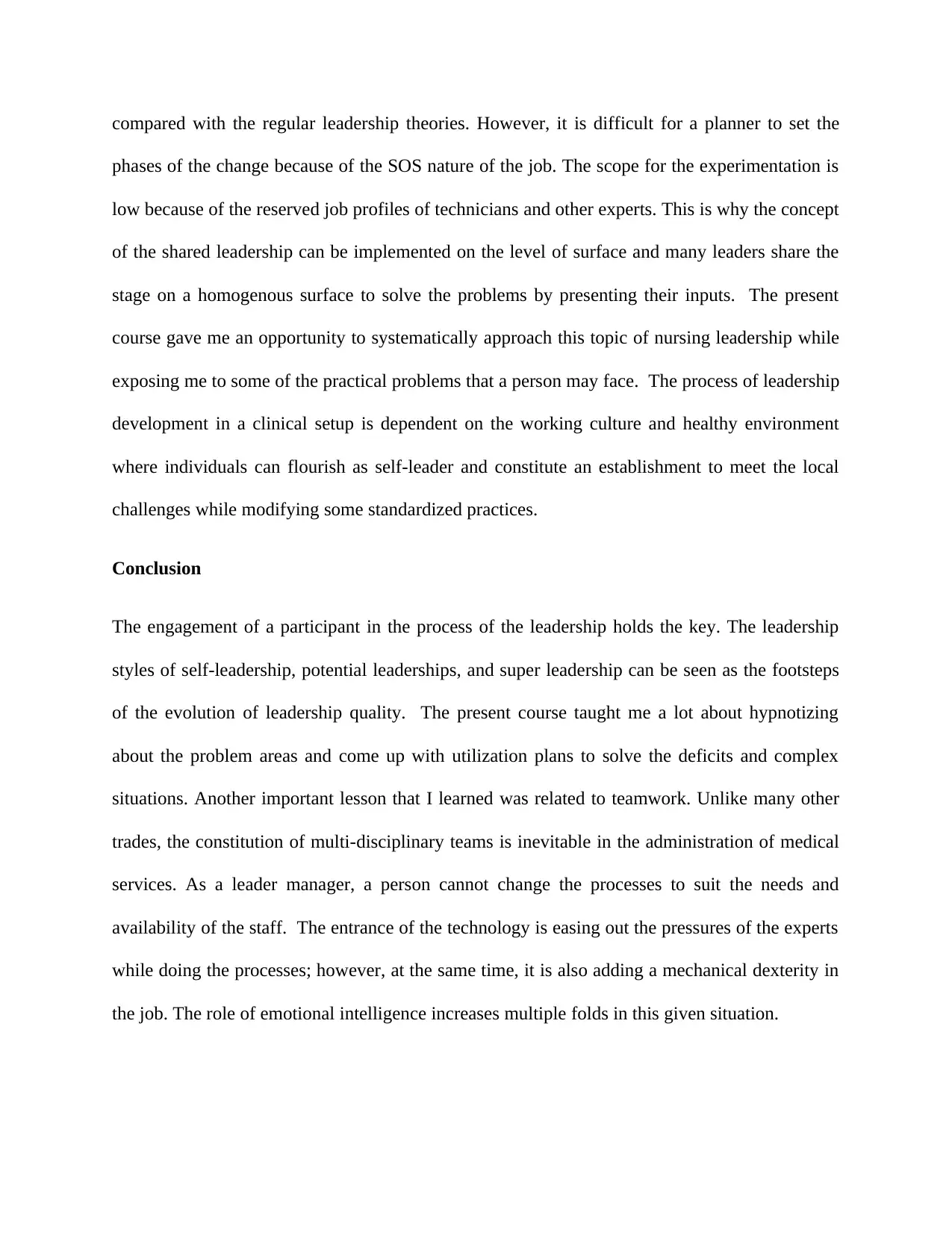
compared with the regular leadership theories. However, it is difficult for a planner to set the
phases of the change because of the SOS nature of the job. The scope for the experimentation is
low because of the reserved job profiles of technicians and other experts. This is why the concept
of the shared leadership can be implemented on the level of surface and many leaders share the
stage on a homogenous surface to solve the problems by presenting their inputs. The present
course gave me an opportunity to systematically approach this topic of nursing leadership while
exposing me to some of the practical problems that a person may face. The process of leadership
development in a clinical setup is dependent on the working culture and healthy environment
where individuals can flourish as self-leader and constitute an establishment to meet the local
challenges while modifying some standardized practices.
Conclusion
The engagement of a participant in the process of the leadership holds the key. The leadership
styles of self-leadership, potential leaderships, and super leadership can be seen as the footsteps
of the evolution of leadership quality. The present course taught me a lot about hypnotizing
about the problem areas and come up with utilization plans to solve the deficits and complex
situations. Another important lesson that I learned was related to teamwork. Unlike many other
trades, the constitution of multi-disciplinary teams is inevitable in the administration of medical
services. As a leader manager, a person cannot change the processes to suit the needs and
availability of the staff. The entrance of the technology is easing out the pressures of the experts
while doing the processes; however, at the same time, it is also adding a mechanical dexterity in
the job. The role of emotional intelligence increases multiple folds in this given situation.
phases of the change because of the SOS nature of the job. The scope for the experimentation is
low because of the reserved job profiles of technicians and other experts. This is why the concept
of the shared leadership can be implemented on the level of surface and many leaders share the
stage on a homogenous surface to solve the problems by presenting their inputs. The present
course gave me an opportunity to systematically approach this topic of nursing leadership while
exposing me to some of the practical problems that a person may face. The process of leadership
development in a clinical setup is dependent on the working culture and healthy environment
where individuals can flourish as self-leader and constitute an establishment to meet the local
challenges while modifying some standardized practices.
Conclusion
The engagement of a participant in the process of the leadership holds the key. The leadership
styles of self-leadership, potential leaderships, and super leadership can be seen as the footsteps
of the evolution of leadership quality. The present course taught me a lot about hypnotizing
about the problem areas and come up with utilization plans to solve the deficits and complex
situations. Another important lesson that I learned was related to teamwork. Unlike many other
trades, the constitution of multi-disciplinary teams is inevitable in the administration of medical
services. As a leader manager, a person cannot change the processes to suit the needs and
availability of the staff. The entrance of the technology is easing out the pressures of the experts
while doing the processes; however, at the same time, it is also adding a mechanical dexterity in
the job. The role of emotional intelligence increases multiple folds in this given situation.
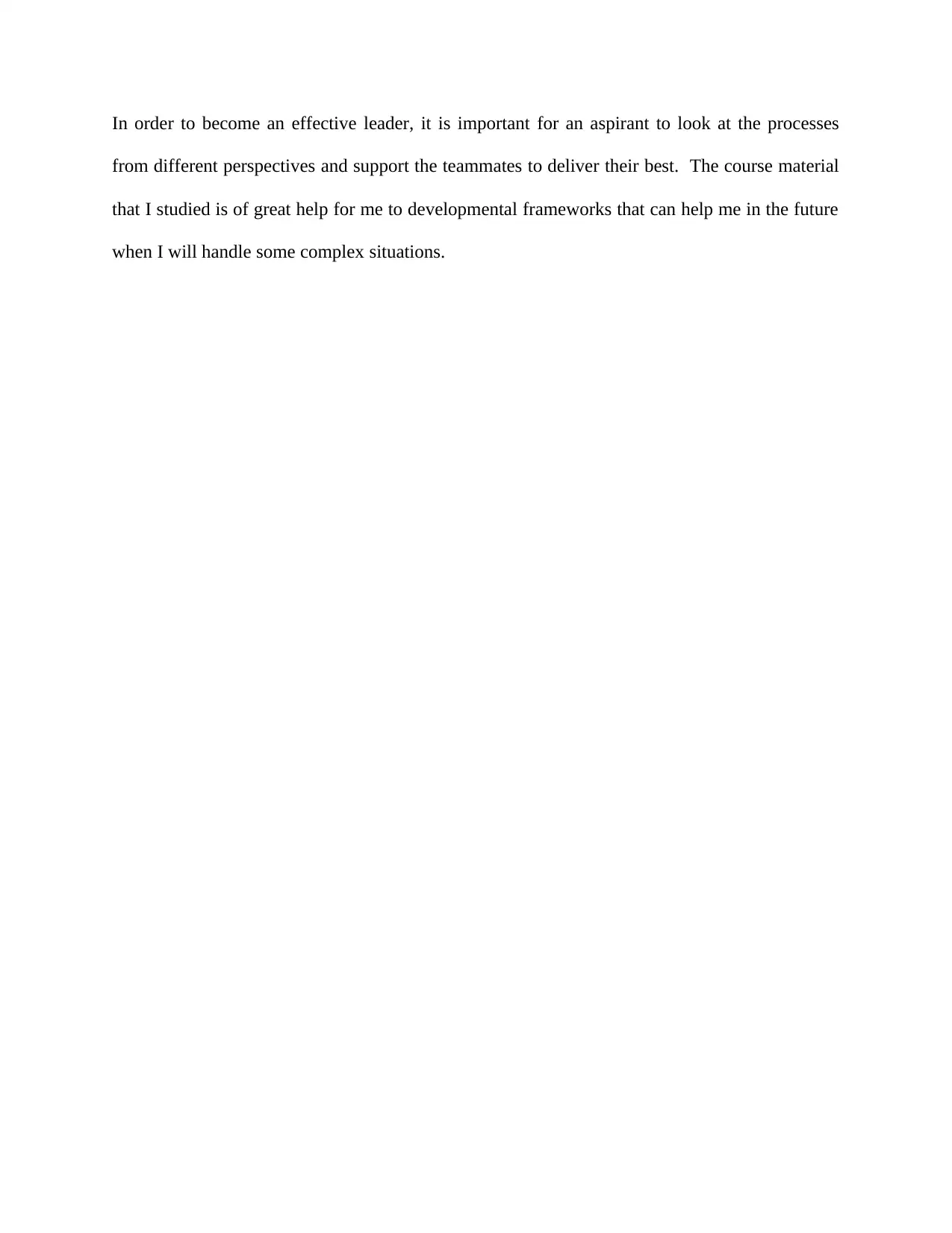
In order to become an effective leader, it is important for an aspirant to look at the processes
from different perspectives and support the teammates to deliver their best. The course material
that I studied is of great help for me to developmental frameworks that can help me in the future
when I will handle some complex situations.
from different perspectives and support the teammates to deliver their best. The course material
that I studied is of great help for me to developmental frameworks that can help me in the future
when I will handle some complex situations.
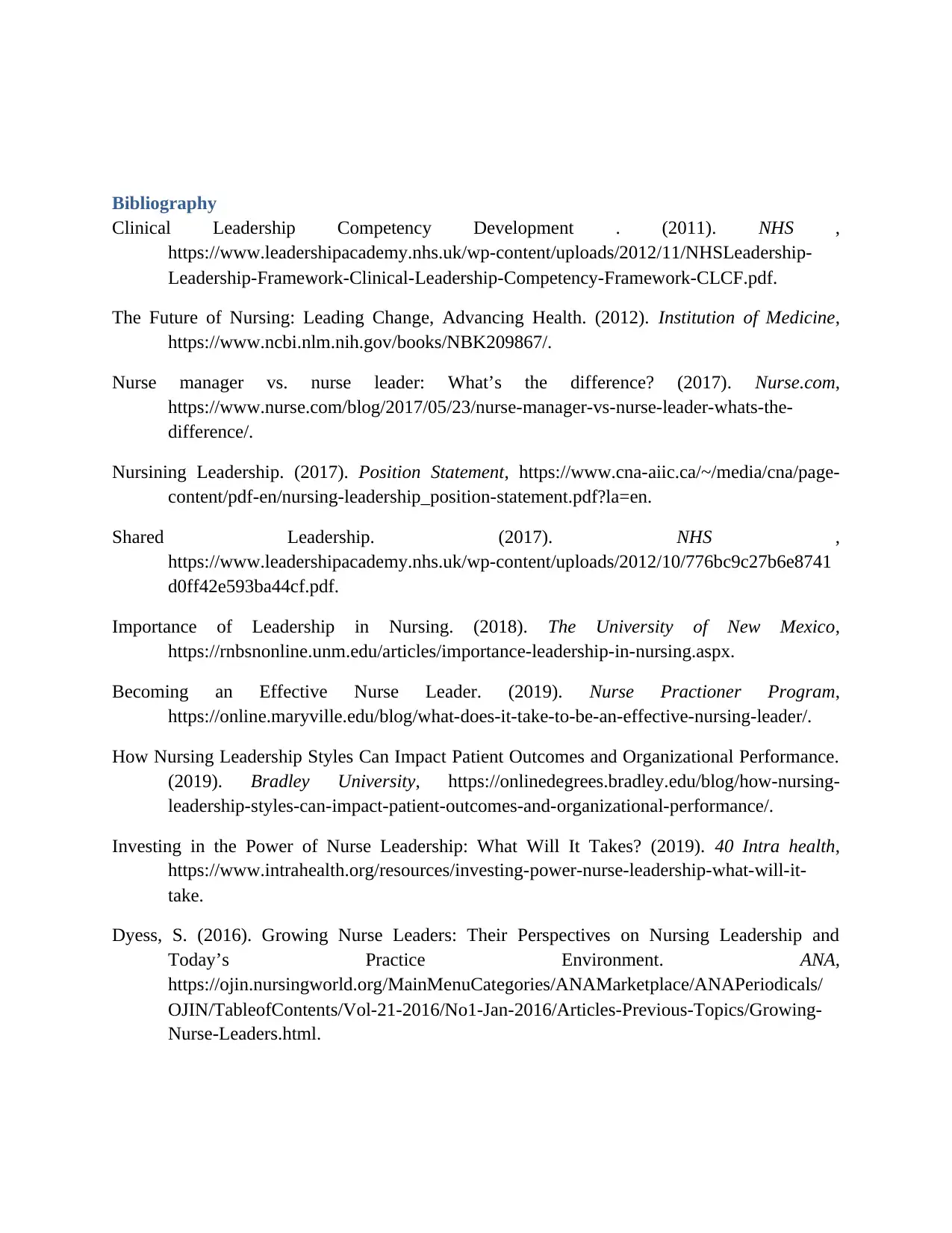
Bibliography
Clinical Leadership Competency Development . (2011). NHS ,
https://www.leadershipacademy.nhs.uk/wp-content/uploads/2012/11/NHSLeadership-
Leadership-Framework-Clinical-Leadership-Competency-Framework-CLCF.pdf.
The Future of Nursing: Leading Change, Advancing Health. (2012). Institution of Medicine,
https://www.ncbi.nlm.nih.gov/books/NBK209867/.
Nurse manager vs. nurse leader: What’s the difference? (2017). Nurse.com,
https://www.nurse.com/blog/2017/05/23/nurse-manager-vs-nurse-leader-whats-the-
difference/.
Nursining Leadership. (2017). Position Statement, https://www.cna-aiic.ca/~/media/cna/page-
content/pdf-en/nursing-leadership_position-statement.pdf?la=en.
Shared Leadership. (2017). NHS ,
https://www.leadershipacademy.nhs.uk/wp-content/uploads/2012/10/776bc9c27b6e8741
d0ff42e593ba44cf.pdf.
Importance of Leadership in Nursing. (2018). The University of New Mexico,
https://rnbsnonline.unm.edu/articles/importance-leadership-in-nursing.aspx.
Becoming an Effective Nurse Leader. (2019). Nurse Practioner Program,
https://online.maryville.edu/blog/what-does-it-take-to-be-an-effective-nursing-leader/.
How Nursing Leadership Styles Can Impact Patient Outcomes and Organizational Performance.
(2019). Bradley University, https://onlinedegrees.bradley.edu/blog/how-nursing-
leadership-styles-can-impact-patient-outcomes-and-organizational-performance/.
Investing in the Power of Nurse Leadership: What Will It Takes? (2019). 40 Intra health,
https://www.intrahealth.org/resources/investing-power-nurse-leadership-what-will-it-
take.
Dyess, S. (2016). Growing Nurse Leaders: Their Perspectives on Nursing Leadership and
Today’s Practice Environment. ANA,
https://ojin.nursingworld.org/MainMenuCategories/ANAMarketplace/ANAPeriodicals/
OJIN/TableofContents/Vol-21-2016/No1-Jan-2016/Articles-Previous-Topics/Growing-
Nurse-Leaders.html.
Clinical Leadership Competency Development . (2011). NHS ,
https://www.leadershipacademy.nhs.uk/wp-content/uploads/2012/11/NHSLeadership-
Leadership-Framework-Clinical-Leadership-Competency-Framework-CLCF.pdf.
The Future of Nursing: Leading Change, Advancing Health. (2012). Institution of Medicine,
https://www.ncbi.nlm.nih.gov/books/NBK209867/.
Nurse manager vs. nurse leader: What’s the difference? (2017). Nurse.com,
https://www.nurse.com/blog/2017/05/23/nurse-manager-vs-nurse-leader-whats-the-
difference/.
Nursining Leadership. (2017). Position Statement, https://www.cna-aiic.ca/~/media/cna/page-
content/pdf-en/nursing-leadership_position-statement.pdf?la=en.
Shared Leadership. (2017). NHS ,
https://www.leadershipacademy.nhs.uk/wp-content/uploads/2012/10/776bc9c27b6e8741
d0ff42e593ba44cf.pdf.
Importance of Leadership in Nursing. (2018). The University of New Mexico,
https://rnbsnonline.unm.edu/articles/importance-leadership-in-nursing.aspx.
Becoming an Effective Nurse Leader. (2019). Nurse Practioner Program,
https://online.maryville.edu/blog/what-does-it-take-to-be-an-effective-nursing-leader/.
How Nursing Leadership Styles Can Impact Patient Outcomes and Organizational Performance.
(2019). Bradley University, https://onlinedegrees.bradley.edu/blog/how-nursing-
leadership-styles-can-impact-patient-outcomes-and-organizational-performance/.
Investing in the Power of Nurse Leadership: What Will It Takes? (2019). 40 Intra health,
https://www.intrahealth.org/resources/investing-power-nurse-leadership-what-will-it-
take.
Dyess, S. (2016). Growing Nurse Leaders: Their Perspectives on Nursing Leadership and
Today’s Practice Environment. ANA,
https://ojin.nursingworld.org/MainMenuCategories/ANAMarketplace/ANAPeriodicals/
OJIN/TableofContents/Vol-21-2016/No1-Jan-2016/Articles-Previous-Topics/Growing-
Nurse-Leaders.html.
Paraphrase This Document
Need a fresh take? Get an instant paraphrase of this document with our AI Paraphraser
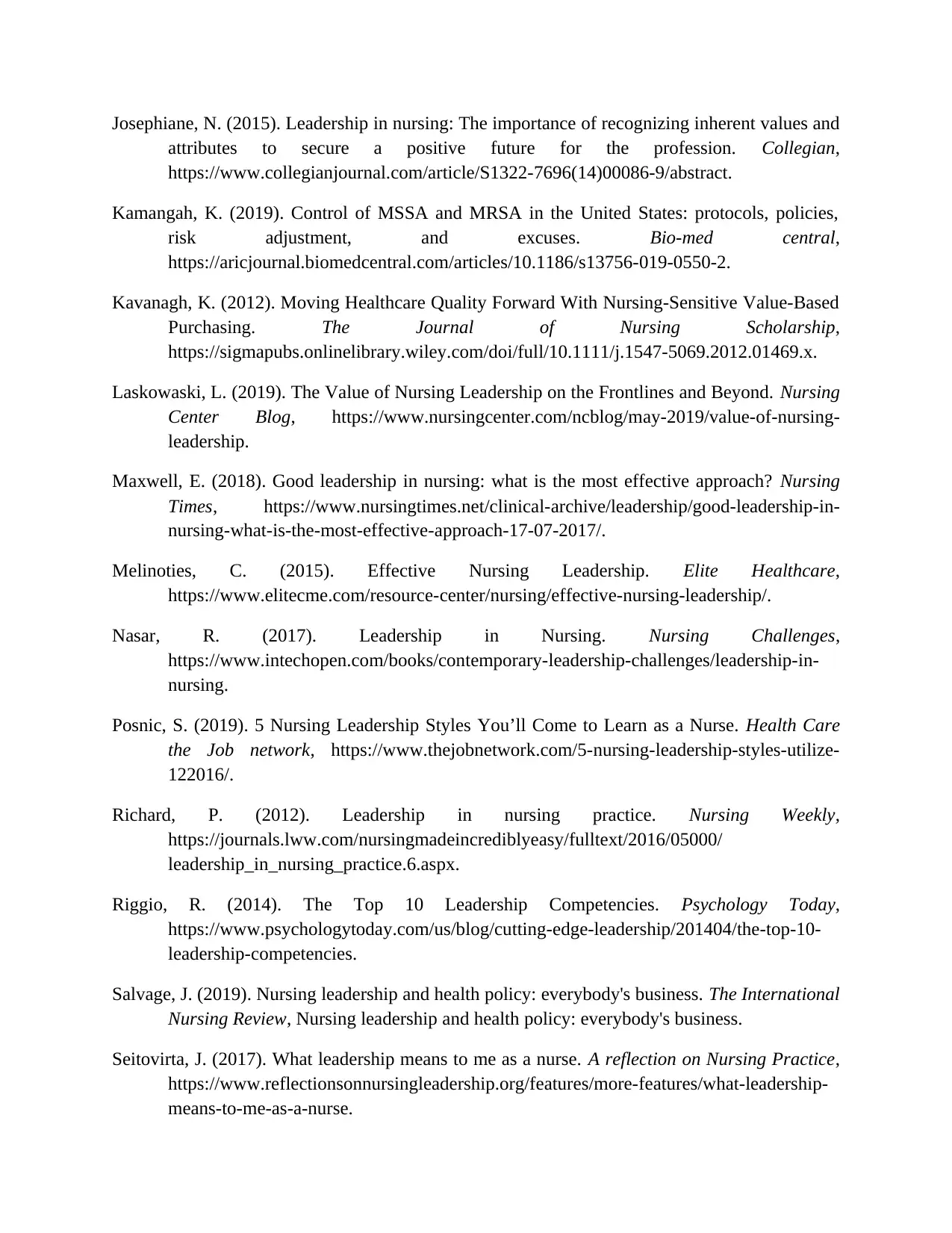
Josephiane, N. (2015). Leadership in nursing: The importance of recognizing inherent values and
attributes to secure a positive future for the profession. Collegian,
https://www.collegianjournal.com/article/S1322-7696(14)00086-9/abstract.
Kamangah, K. (2019). Control of MSSA and MRSA in the United States: protocols, policies,
risk adjustment, and excuses. Bio-med central,
https://aricjournal.biomedcentral.com/articles/10.1186/s13756-019-0550-2.
Kavanagh, K. (2012). Moving Healthcare Quality Forward With Nursing‐Sensitive Value‐Based
Purchasing. The Journal of Nursing Scholarship,
https://sigmapubs.onlinelibrary.wiley.com/doi/full/10.1111/j.1547-5069.2012.01469.x.
Laskowaski, L. (2019). The Value of Nursing Leadership on the Frontlines and Beyond. Nursing
Center Blog, https://www.nursingcenter.com/ncblog/may-2019/value-of-nursing-
leadership.
Maxwell, E. (2018). Good leadership in nursing: what is the most effective approach? Nursing
Times, https://www.nursingtimes.net/clinical-archive/leadership/good-leadership-in-
nursing-what-is-the-most-effective-approach-17-07-2017/.
Melinoties, C. (2015). Effective Nursing Leadership. Elite Healthcare,
https://www.elitecme.com/resource-center/nursing/effective-nursing-leadership/.
Nasar, R. (2017). Leadership in Nursing. Nursing Challenges,
https://www.intechopen.com/books/contemporary-leadership-challenges/leadership-in-
nursing.
Posnic, S. (2019). 5 Nursing Leadership Styles You’ll Come to Learn as a Nurse. Health Care
the Job network, https://www.thejobnetwork.com/5-nursing-leadership-styles-utilize-
122016/.
Richard, P. (2012). Leadership in nursing practice. Nursing Weekly,
https://journals.lww.com/nursingmadeincrediblyeasy/fulltext/2016/05000/
leadership_in_nursing_practice.6.aspx.
Riggio, R. (2014). The Top 10 Leadership Competencies. Psychology Today,
https://www.psychologytoday.com/us/blog/cutting-edge-leadership/201404/the-top-10-
leadership-competencies.
Salvage, J. (2019). Nursing leadership and health policy: everybody's business. The International
Nursing Review, Nursing leadership and health policy: everybody's business.
Seitovirta, J. (2017). What leadership means to me as a nurse. A reflection on Nursing Practice,
https://www.reflectionsonnursingleadership.org/features/more-features/what-leadership-
means-to-me-as-a-nurse.
attributes to secure a positive future for the profession. Collegian,
https://www.collegianjournal.com/article/S1322-7696(14)00086-9/abstract.
Kamangah, K. (2019). Control of MSSA and MRSA in the United States: protocols, policies,
risk adjustment, and excuses. Bio-med central,
https://aricjournal.biomedcentral.com/articles/10.1186/s13756-019-0550-2.
Kavanagh, K. (2012). Moving Healthcare Quality Forward With Nursing‐Sensitive Value‐Based
Purchasing. The Journal of Nursing Scholarship,
https://sigmapubs.onlinelibrary.wiley.com/doi/full/10.1111/j.1547-5069.2012.01469.x.
Laskowaski, L. (2019). The Value of Nursing Leadership on the Frontlines and Beyond. Nursing
Center Blog, https://www.nursingcenter.com/ncblog/may-2019/value-of-nursing-
leadership.
Maxwell, E. (2018). Good leadership in nursing: what is the most effective approach? Nursing
Times, https://www.nursingtimes.net/clinical-archive/leadership/good-leadership-in-
nursing-what-is-the-most-effective-approach-17-07-2017/.
Melinoties, C. (2015). Effective Nursing Leadership. Elite Healthcare,
https://www.elitecme.com/resource-center/nursing/effective-nursing-leadership/.
Nasar, R. (2017). Leadership in Nursing. Nursing Challenges,
https://www.intechopen.com/books/contemporary-leadership-challenges/leadership-in-
nursing.
Posnic, S. (2019). 5 Nursing Leadership Styles You’ll Come to Learn as a Nurse. Health Care
the Job network, https://www.thejobnetwork.com/5-nursing-leadership-styles-utilize-
122016/.
Richard, P. (2012). Leadership in nursing practice. Nursing Weekly,
https://journals.lww.com/nursingmadeincrediblyeasy/fulltext/2016/05000/
leadership_in_nursing_practice.6.aspx.
Riggio, R. (2014). The Top 10 Leadership Competencies. Psychology Today,
https://www.psychologytoday.com/us/blog/cutting-edge-leadership/201404/the-top-10-
leadership-competencies.
Salvage, J. (2019). Nursing leadership and health policy: everybody's business. The International
Nursing Review, Nursing leadership and health policy: everybody's business.
Seitovirta, J. (2017). What leadership means to me as a nurse. A reflection on Nursing Practice,
https://www.reflectionsonnursingleadership.org/features/more-features/what-leadership-
means-to-me-as-a-nurse.
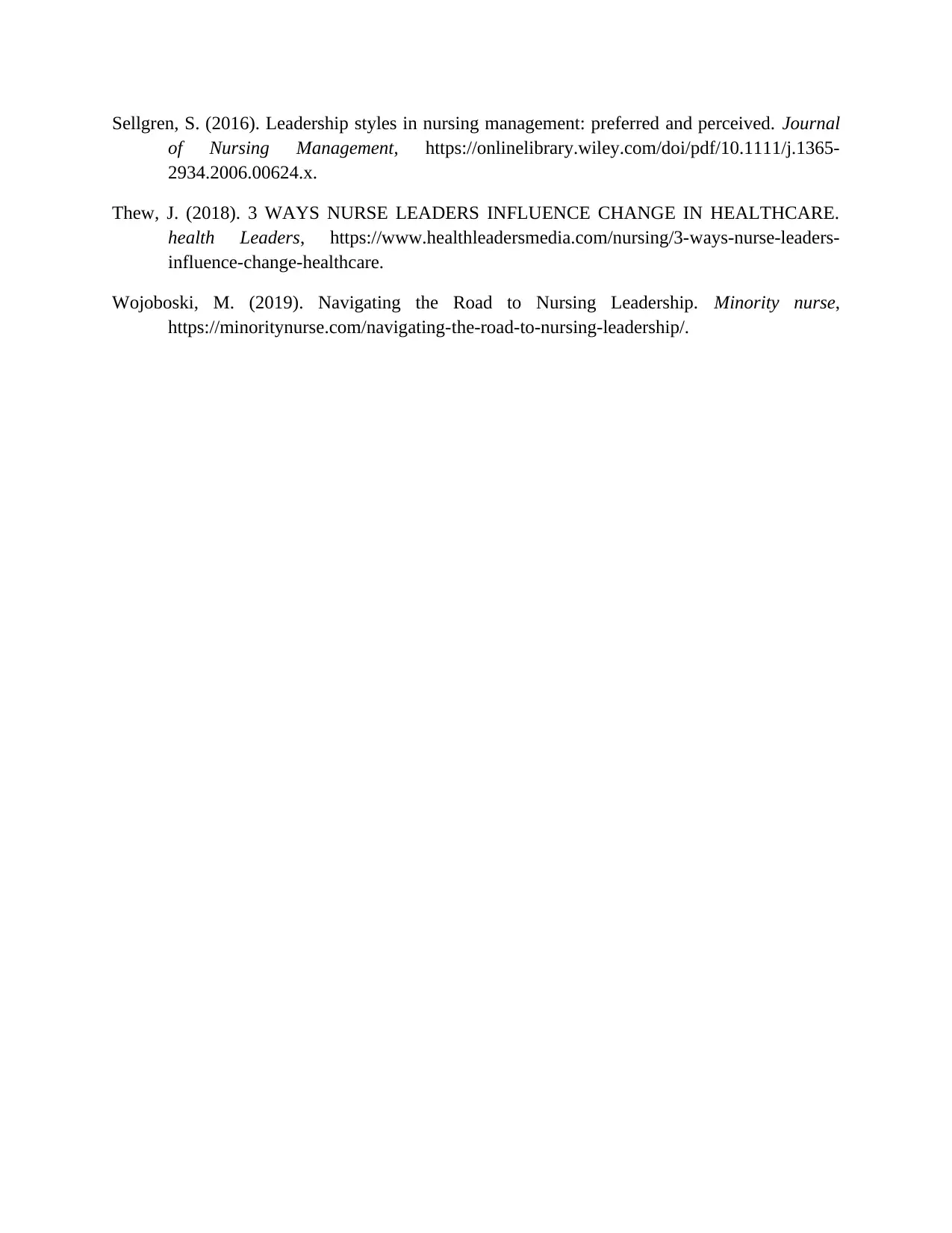
Sellgren, S. (2016). Leadership styles in nursing management: preferred and perceived. Journal
of Nursing Management, https://onlinelibrary.wiley.com/doi/pdf/10.1111/j.1365-
2934.2006.00624.x.
Thew, J. (2018). 3 WAYS NURSE LEADERS INFLUENCE CHANGE IN HEALTHCARE.
health Leaders, https://www.healthleadersmedia.com/nursing/3-ways-nurse-leaders-
influence-change-healthcare.
Wojoboski, M. (2019). Navigating the Road to Nursing Leadership. Minority nurse,
https://minoritynurse.com/navigating-the-road-to-nursing-leadership/.
of Nursing Management, https://onlinelibrary.wiley.com/doi/pdf/10.1111/j.1365-
2934.2006.00624.x.
Thew, J. (2018). 3 WAYS NURSE LEADERS INFLUENCE CHANGE IN HEALTHCARE.
health Leaders, https://www.healthleadersmedia.com/nursing/3-ways-nurse-leaders-
influence-change-healthcare.
Wojoboski, M. (2019). Navigating the Road to Nursing Leadership. Minority nurse,
https://minoritynurse.com/navigating-the-road-to-nursing-leadership/.
1 out of 15
Related Documents
Your All-in-One AI-Powered Toolkit for Academic Success.
+13062052269
info@desklib.com
Available 24*7 on WhatsApp / Email
![[object Object]](/_next/static/media/star-bottom.7253800d.svg)
Unlock your academic potential
© 2024 | Zucol Services PVT LTD | All rights reserved.




